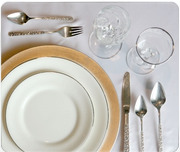Mind Your Manners OR A Brief Etiquette Spread
At your wedding or any other time, your great smile and perfect physique may not be enough to compensate for your fumbling through a 12- to 20-piece formal place setting. Instead of sentencing yourself to a fake-it-till-you-make-it evening, brush up on your grace with our brief etiquette spread. Or learn how to set the table for a proper wedding lunch or dinner.
Warning:
Because the primary purpose of etiquette is to make people feel comfortable in social situations by establishing accepted standards, the most egregious thing a person can do is use it pretentiously, especially by openly correcting anyone. Etiquette — “a code of behavior based on thoughtfulness,” according to The Emily Post Institute — isn’t to be wielded like a weapon of arrogance or superiority.
Decorative plate
The charger plate serves as an under plate for one or more courses before the main entree is served, at which point the plate will likely be removed.
Tear it
Your bread plate is always to your upper left, above your forks. Do not slice and butter your entire roll or biscuit at once. Rather, you should eat it by tearing off bite-sized pieces with your hands; butter each piece individually as you eat.
Keep it straight
At crowded tables where settings are tightly placed, it’s often confusing which glasses and side plates are designated to each guest. Just remember, solids go to your left (butter, salad plate, etc.) and liquids to your right.
Don’t soil the cloth
Used utensils should never be set directly onto the table. If you are finished, or resting your fork or spoon momentarily during conversation, set your fork or spoon on its given dish or horizontally on the top of the charger plate. If a neighbor accidentally takes your plate, don’t use your other neighbor’s; instead, discreetly ask the server for another plate.
Prong preparation
Forks are placed in the order their course is served. Work from outside inward. If there are three forks: salad (left), fish/appetizer (center), main entree (right).
Contrary to the more practical continental style, there is an American insistence that no food morsel — not even a stubborn pea! — should be aided onto the fork. In Europe, on the other hand, it is permitted to use a knife or bread to assist the food onto your fork.
Knives & cutting
Never cut more than one or two bites at a time. Emily Post coined the American “Zig-zag” cutting technique still in use today, a style that says the diner should hold the fork, tines down, in her left hand and the knife in her right. After cutting one or two morsels she should place the knife down (not on the table), and transfer the fork to the right hand where the food is lifted to the mouth. The left hand rests in the lap. Always cut by drawing the knife toward you, never cut in a back-and-forth sawing motion. Knives are always placed with cutting edge toward the plate. A butter knife (not shown here) is placed diagonally across the butter plate, handle to the right.
Glassware
These crystal babies can number anywhere from two to five depending on the place setting; most of those glasses are customarily designated for alcohol. Don’t turn your glass over to refuse an alcoholic drink; instead, politely refuse verbally. Your water goblet is placed directly above your dinner knife. You may sip water after everyone is seated, but wait to drink anything else until everyone has been served or your host invites you to do otherwise.
The scoop on spoons
Spoons are placed to the right of the knives. Scoop away from yourself with soup, toward you with everything else. And slurp quietly — don’t sip — from the side of the spoon, not its end, when eating soup. It’s OK, even flattering to the hostess, to tilt the bowl away from you to scoop the last dribble of soup.
Napkins
Napkins are placed on the charger plate or to the left of the forks. It belongs on your lap, not tucked in your shirt like a bib. It is to be laid on your lap, folded in half, with the fold toward you. Dab your mouth often. If you’re done eating or must excuse yourself from the table momentarily, fold the napkin next to your plate or hang it over the back of your chair. Never leave it on your seat.
Dessert
The dessert fork and spoon are placed above the charger plate: the bowl of the spoon to the left, and fork’s tines to the right. At more formal occasions, they are brought in separately with the dessert.
In general:
•Pass dishes to your right, counterclockwise.
•The salt and pepper are always passed together.
Sources: “Emily Post’s Etiquette, 17th Edition,” by Peggy Post; “From Hand to Mouth, Or, How We Invented Knives, Forks, Spoons and Chopsticks, and the Manners to Go with Them,” by James Cross Giblin; “The History of Manners” by Norbert Elias.
See our complete designed page by downloading the PDF version HERE.
By Jacob Hancock
Mormon Times – Apr. 15, 2010
E-mail: jhancock@desnews.com
Copyright © 2009 Deseret News Publishing Company
http://www.mormontimes.com/mormon_living/tips_living/?id=14371
